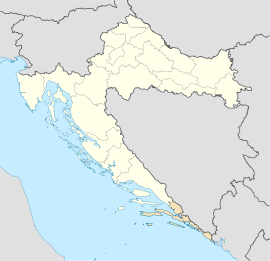Cavtat
| Cavtat | ||
|
|
||
| Basic data | ||
|---|---|---|
| State : |
|
|
| County : |
|
|
| Municipality : | Konavle | |
| Height : | 0 m. i. J. | |
| Residents : | 2,015 (2001) | |
| Telephone code : | (+385) 020 | |
| Postal code : | 20 210 | |
| License plate : | YOU | |
| Boat registration : | CT | |
| Structure and administration | ||
| Website : | ||
Cavtat [ ˈtsaʋtat ] ( Latin Epidaurus , Italian Ragusavecchia ) is a Croatian village in the historical region of Dalmatia, 20 km south of Dubrovnik with 2,015 inhabitants (2001). The administrative center of Konavle Municipality is in Cavtat .
Location, description
The town was planned on the slopes of the Rat peninsula on the edge of the Konevletal. Cavtat has its own port captain ( Croatian : Lučka Kapetanija ) and a customs pier ( Croatian : Carina ), which makes the port particularly attractive for yachts. The distance to Dubrovnik Airport is approx. 5 km.
There are some preserved cultural and historical buildings in the village, as well as accommodation and restaurants for the growing number of tourists. Sports and cultural opportunities such as tennis courts, marked hiking trails or a diving school are available to guests, as is the Bogišić collection (including around 70 valuable incunabula , 10 p.m. rare books, graphics, coins, and weapons) and the Bukovac gallery.
Annually in summer ( Cavtater Sommer ) and in winter the city attracts guests from near and far with a carnival event .
history
In ancient times , the Greek settlement of Epidauros was located here . Under the name Epidaurum under the Roman rule and later was also a Roman colony . In the Middle Ages, the place was expanded according to plan, but due to its location in a small area.
The place was badly damaged in the earthquake of 1667 .
During the Croatian War and the Battle of Dubrovnik in 1991 Cavtat u. a. Shot at from the sea or later controlled by the Yugoslav People's Army . Most of the numerous damage has now been repaired, but some buildings such as the Makedonia Hotel had to be demolished.
Buildings and monuments (selection)
- Franciscan monastery with the monastery church Maria Schnee on the banks of the Adriatic Sea
- The monastery was built between 1484 and the end of the 16th century. Extensive structural changes were made in the 18th and 20th centuries. On the east wing of the complex is the monastery church, dedicated to the Virgin of the Snow. Inside, an altar piece from the 15th century and impressive paintings have been preserved. The church was given its current appearance in 1909.
- The monastery garden is in the north wing of the monastery complex; further parts of the building were added in the 19th century, when seamen (sailors) also sought consolation and accommodation here.
- St. Nikolai Church
- Inside there is a valuable painting by the Dubrovnik painter Carmelo Reggio Palermitanc .
- The mausoleum of the Račić family of sailors stands in the middle of the town cemetery
- The building of the mausoleum dominates the entire hill and can be seen from far in the brilliant white. It carries a bronze kneeling angel of peace on the top of the dome roof . Below, in a lantern , hangs a bell in relief , showing scenes from Christ's ordeal and bearing the following inscription: "If you know the mystery of love, you can also solve the mystery of death and believe that life is eternal."
- The design of the building and the jewelry took place in 1920–1922 according to plans by the sculptor Ivan Meštrović . The mausoleum replaces a previous chapel for the well-known family.
- Monument to Frano Supilo
- Monument to Valtazar Bogišić
sons and daughters of the town
- Valtazar Bogišić , famous lawyer and book lover
- Vlaho Bukovac , Croatian painter
- Tino Pattiera , tenor singer and actor
- Seafaring family Račić
- Mate Šarlija (called Daidža ), General of the HV and HVO
- Frano Supilo , politician and journalist who advocated Croatia's national interests early on; born in Cavtat
Web links
- Konavle tourist office with links to a short description and pictures (Croatian / English)
- Cavtatportal.com: Your Guide to Everything Cavtat
- Cavtat info
Individual evidence
- ↑ a b Flyer Cavtat , published by the Tourist Board of Konavle, Cavtat , as of 2017; Croatian / English / German.
- ↑ Paola Albini: The Great 1667 Dalmatia Earthquake: An In-Depth Case Study. Springer, Cham / Heidelberg / New York / Dortrecht / London 2015, ISBN 978-3-319-16208-9 , p. 67 ( limited preview in the Google book search).
- ↑ Information from the explanation board at the church (Croatian, English), seen and photographed in June 2017.
- ↑ Information from the explanation board at the mausoleum (Croatian, English), seen and photographed in June 2017.



